According to Statista, the number of mobile app downloads worldwide is projected to grow to 258.2 billion by 2022. That’s an increase of nearly 26% from the reported 205.4 billion in 2018. For performance marketers, this presents a huge opportunity as well as their biggest challenge: how to get the largest slice of that pie possible.
However, new installs aren’t the only KPI marketers care about. Those new installs need to be acquired at a reasonable cost – and be of high enough quality to lead to engagement, retention, and ultimately revenue. Think CPA, LTV, DAU, MAU, and more.
So where should you focus your app promotion efforts – and direct your budget – in order to maximize user acquisition results and ROI?
Here are 9 ways to promote an app that will help you maximize ROI and crush your KPIs:
1. Start with App Store Optimization (ASO)
ASO is number one on our list because it is the most crucial step to any user acquisition strategy. You can run the most effective paid ad campaign in the world, but if the users who click on your ads get routed to a low-quality app download page with poor information and design, there’s little chance those users will actually convert to install.
A few tactics for effective ASO:
- Start with an eye-catching app icon and catchy title.
- Write a clear and compelling app description (full and short).
- Select informative, cohesive, and well-designed screenshots. Consider a promo video to make your app stand out.
- Prompt customers to review your app and directly respond to any negative reviews. Be sure to provide a support contact on your app store page to help mitigate negative reviews.
- Improve your app’s rankings through careful keyword selection. Relevancy is key.
Here’s an example of a well-designed app store product page:
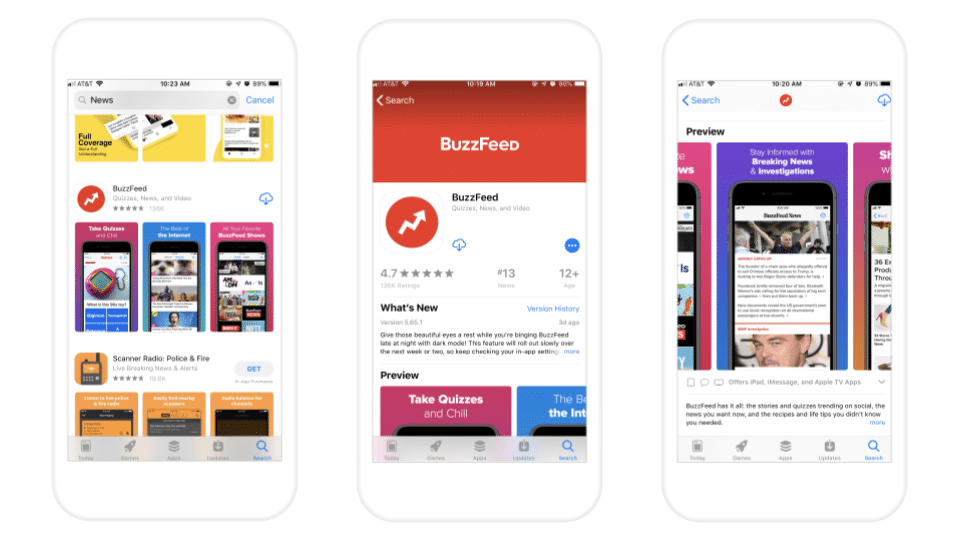
2. Leverage Your Mobile Website
If you have a website and a mobile website, you likely already have an SEO strategy in place. Why not leverage this effective and cost-efficient channel to drive users into the app where they’re more likely to convert?
Using deep-linked smart banners, you can capture web visitors and drive them seamlessly into your app. Branch’s Journeys solution can help you increase your web-to-app conversion rate by up to 2X through personalized app banners.
Let’s take a look at how that flow can work on mobile when implemented correctly:
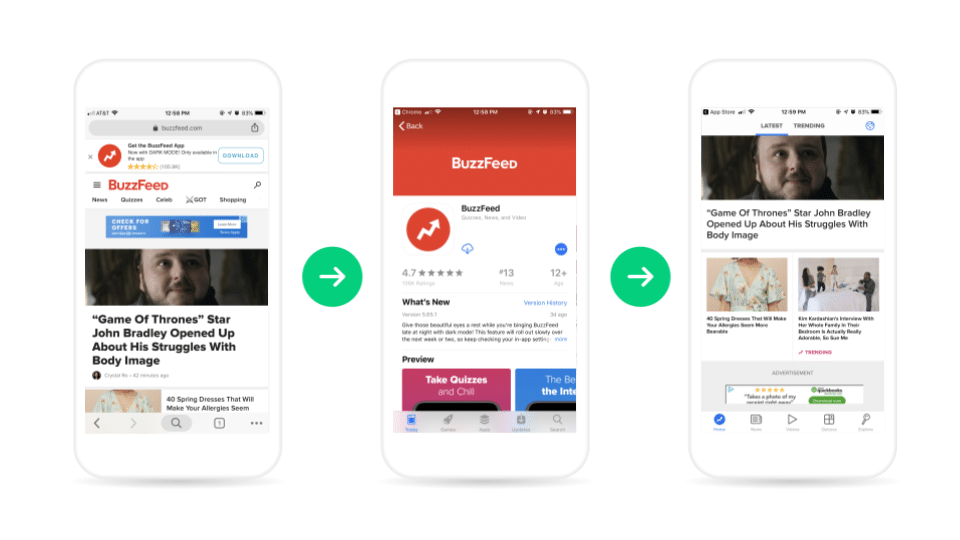
Don’t have a website? You can still leverage the mobile web for app promotion by enabling Branch’s Deepviews Content Preview solution. Deepviews allows users to easily access your app content on any device (even desktop).
3. Drive Interest on Social Media
Both paid and organic social media are powerful channels for reaching a large audience of potential app users.
Sharing content on social is simple and easy – but it can be hard to track performance for organic and paid posts across major channels like LinkedIn, Facebook, Twitter, and Snapchat.
The good news: Utilizing deep links, you can route users directly to content within your app, even through install. With this strategy, Branch has seen brands significantly increase their retention rates.
Here’s an example of a user clicking a deep-linked “Book Now” button on Airbnb’s Facebook page where they’re then directed out of Facebook and directly into the Airbnb app:
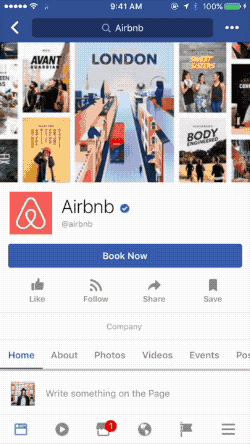
Using Branch deep links in both your organic and paid social posts allows you to route users seamlessly into your app from any device or channel – all using a single link.
Even better: For your paid social campaigns, you can track this journey to gain full visibility into your campaign ROI with Branch’s Universal Ads solution. Branch’s attribution allows you to understand the full-funnel customer journey from social media engagement to click to install to conversion.
4. Encourage Referrals
According to Annex Cloud, 92% of consumers trust referral marketing and are 4X more likely to purchase a product if a friend or family member recommends it. For these reasons, referrals offer a huge opportunity to reach new audiences of highly engaged potential users primed for purchase.
But one major challenge is accurately attributing the performance of referral campaigns.
One solution: With deep-linked referrals, rewards are automatically applied and new and existing users see personalized experiences without the need for promo codes. From this improved referral experience, we’ve seen brands increase conversion from referral to sign up by 31%.
To encourage mobile referrals, enable sharing from within the app and consider offering incentives in the form of discount codes.
5. Re-engage Lapsed Users
In addition to capturing new app users, you must dedicate time and resources to retain those users and keep them engaged. Otherwise, you can expect to be disappointed by the ARPU your mobile growth strategy produces.
Considering 21% of mobile users will abandon an app after just one use, according to a Localytics study, you can expect a quick dropoff of users without a solid re-engagement strategy.
To learn more about how to retarget your app users, read Mobile App Retargeting: Benefits and Best Practices.
6. Answer Questions on Public Forums
In October 2018, according to Statista, Google processed 10.34 billion search queries. Many of those searches are in the form of a question that will likely route that user to an open forum website such as Quora, StackOverflow, or Reddit. But there’s a caveat.
According to Google, the number of Google searches taking place on mobile devices has outnumbered those taking place on computers, in 10 countries including the US and Japan, since 2015. These stats present an opportunity for you to insert your app as the answer to those questions.
While you should take care to not be blatantly self-promotional, answering questions that your target users might be querying on Google is a highly effective way to boost overall brand awareness.
7. Optimize Email for Mobile
Statista reports that the Apple iPhone email client accounted for the largest percentage of email opens in 2018 at 29%, followed by Gmail with 27%. Mobile is now the platform of choice for reading email.
Even more compelling? Yes Lifecycle Marketing found that in 2017, the percentage of email-driven revenue coming from mobile orders increased 33% from the prior year (totaling 46% of all email-driven revenue), while tablet and desktop orders declined 14% and 18%.
As a result, promotional emails must effectively drive into the app in a way that’s attributable. One way to do just that: Leverage deep links within emails to boost email-to-app traffic and improve the customer experience. With deep-linked emails, you can drive new users to the app store to download, then to in-app content, rather than to your mobile website.
Learn more about Branch’s Universal Email solution to increase in-app usage and drive higher conversions.
8. Drive Users from Desktop to the App
If you have a website that drives a lot of traffic on desktop, a great way to convert some of those users to app users is offering a text-me-the-app option on your website.
Take this example from Yelp:
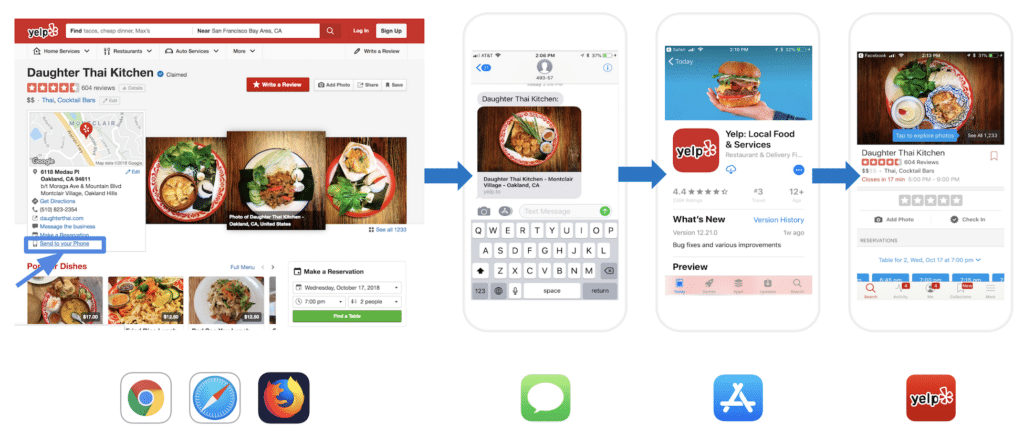
In this example, a user finds a restaurant on Yelp’s desktop site and clicks “Send to your Phone” to text a deep link to their phone which routes them to the appropriate app store, then to the correct restaurant within the app once they’ve installed.
Find out more about how Branch’s Text Me The App is driving results for GoEuro, one of the world’s leading travel apps.
9. Leverage Paid Mobile Advertising
According to eMarketer, global media ad spending topped $628 billion in 2018. The largest percentage of that spend went to paid mobile advertising: a highly effective, predictable, and scalable app promotion method.
Mobile advertising accounted for 67% of digital advertising and 29% of total media advertising in 2018, reports eMarketer. Why should you contribute to these growing numbers? For the flexibility and control mobile advertising offers, allowing you to maximize the number of profitable, high-quality installs within a given CPA.
There are a number of different types of mobile advertising you can leverage including display, search, social, video, and native. Here’s an example for each of those categories:
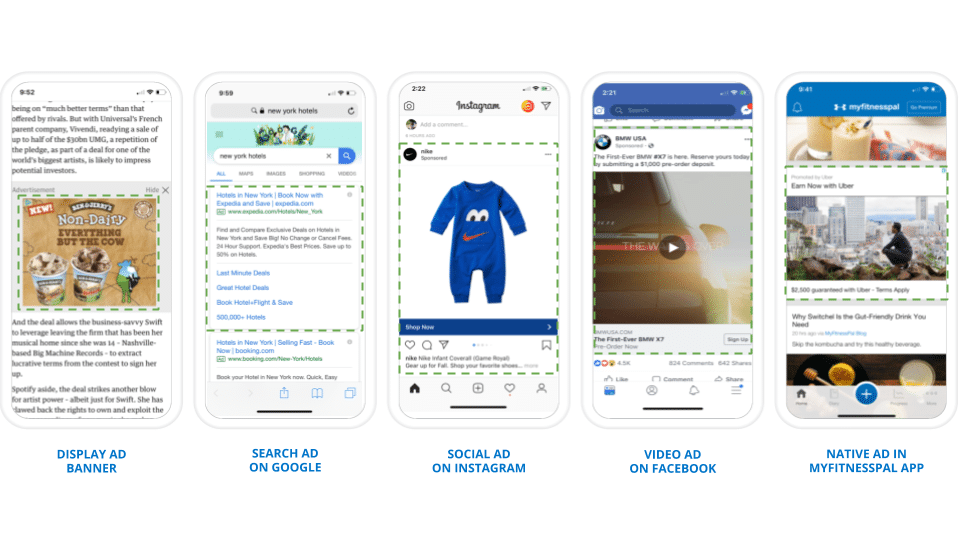
(For more information on the mobile advertising landscape and resources to help plan effective mobile ad campaigns that maximize ROI, read The Basics of Mobile Advertising: A Primer for Those New to the Game.)
Combining paid and organic efforts for promoting an app will help ensure you meet all your app user acquisition KPIs: new installs, cost-per-install, user engagement, retention, and most importantly revenue (or ARPU).
Ready to uplevel your app promotion initiatives across channels with Branch’s deep linking and attribution? Schedule a time to chat with someone on our sales team to get started today.
Have an app promotion tactic to add? Share in the comments below or tweet us @branchmetrics.






















